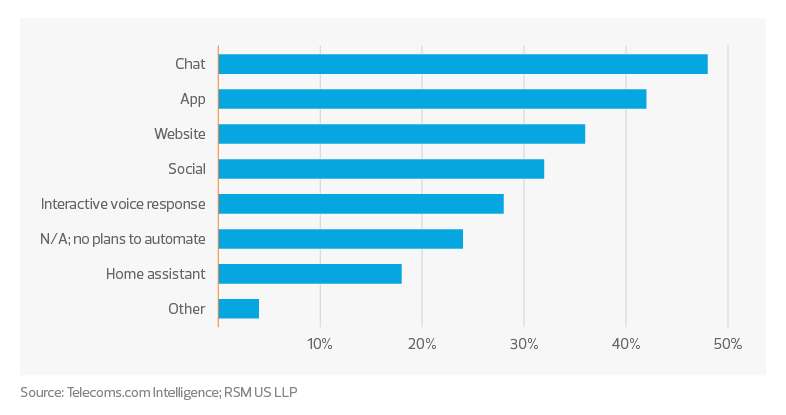Telecom carriers are looking to AI, ML and robotic process automation to reduce costs and optimize network performance.
Key takeaways
Carriers can manage and expand their network capabilities using virtual, software-based applications.
AI can help manage risks presented by an overwhelming number of access points with a more versatile decision-making program.
Amid a time of exorbitant capital expenditures to deploy 5G and fiber networks, as well as escalating labor and energy costs, telecom carriers are increasingly turning to artificial intelligence, machine learning and robotic process automation to reduce operating costs and optimize network performance.
As TM Forum noted in its Cloud and automation: Changing CSPs’ OpEx outlook, revenue growth has proven elusive for telecom carriers, forcing them to focus increasingly on cost management and, more recently, cost cutting. With customers requiring faster speeds and greater reliability to satisfy their insatiable demand for connectivity, reducing investment in the network is not an option. Carriers have focused on reducing operating expenses rather than capital expenses because a large proportion of capex—60% to 90%—is focused on the network. Opex also comprises 2.5 to three times more spend than capex, so it is more ripe for cost-cutting initiatives.
In support of emerging and evolving automation opportunities, telcos benefit from a vast amount of network and customer usage data that has massive potential for actionable, real-time insights and predictive analysis. Use of AI technologies allows these telcos to immediately respond to those insights and adjust accordingly.
The opportunities presented by AI, ML and RPA are endless, but the following are some key processes already in place with large cap carriers that should be seriously considered by middle market carriers facing the same risks, challenges and opportunities.
Network optimization
With the advent of network functions virtualization, telecom carriers can now manage and expand their network capabilities on demand using virtual, software-based applications where physical boxes once stood in network architecture. According to Ericsson, this technology makes it easier to load-balance, scale up and down, and move functions across distributed hardware resources.
In Telecoms.com Intelligence’s most recent evaluation of NFV, in its 2018 annual industry survey report, nearly 80% of industry respondents agreed the technology would be critical or important for their company within the next five years. The top benefits of NFV as highlighted by respondents included:
- Greater network and services flexibility (48% of respondents)
- Increased efficiency of operations (44%)
- Reduced opex (40%)
- Reduced capex (36%)
- Improved network performance and reliability (35%)
Operations enahncements
Truck rolls—field service visits in which an engineer is dispatched to resolve a potential operational issue—are a significant expense for telecom companies of all sizes. In addition to labor and transportation expenses, there is a reputational cost: Carriers must respond quickly to repair the network. One key metric, mean time to repair, can differentiate good carriers from bad ones, as it represents a carrier’s ability to reliably keep its network running.
According to the Technology & Services Industry Organization, each truck roll costs more than $1,000. By implementing intelligent automation—a combination of AI and RPA—telcos can efficiently identify, diagnose and respond to operational issues remotely, dispatching field services only when needed.
Network security enhancements
According to Cujo AI, a developer of AI solutions for connected devices, telecommunications networks are some of the most data-intensive businesses in the world due to their scale. For example, tier 1 internet service providers have hundreds of millions of devices connecting to each other constantly. AI is a valuable and necessary solution for the risks presented by the overwhelming volume of access points. It provides a decision-making program more versatile than traditional solutions: It goes beyond rules-based approaches and can prevent some novel threats thanks to ML, pattern detection and rapid response time. AI is particularly useful for preventing both traditional malware attacks and other emerging, rapidly changing risks.
According to ABI Research, successful deployment of AI for network security will require an amalgamation of intelligence gathered from several different systems, including security information and event management, user and entity behavior analytics, intrusion detection or prevention systems, unified threat management, next-generation firewalls and a steady stream of application programming interface data from cloud vendors.
AI and ML are capable of analyzing data from those disparate sources to identify high-risk anomalies and either take action or provide real-time recommendations to decision-makers.
Customer service enhancements
Customer service centers serve a critical purpose for telecom carriers. Not only do they help customers navigate technical or billing questions, they also present valuable opportunities for carriers to offer more profitable service plans or add-on services. Typically, call centers come with significant opex because of the head count necessary to effectively operate them.
AI can optimize customer service in a number of ways. Advanced bots can facilitate many of the basic conversations that would historically require human interaction. They can also play a key role in validating the customer, which is a critical step for telecom carriers given the vast amount of sensitive customer information they retain. Recognizing the value of this technology, Microsoft acquired AI company Nuance Communications earlier this year for $19.7 billion.
In its 2021 annual industry survey report, Telecoms.com Intelligence noted significant participant enthusiasm for investing in technical self-service support tools in customer interaction channels to improve customer service key performance indicators. These KPIs include average handling time, first-call resolution rate, customer satisfaction score and case escalation rate.
Greatest anticipated uplift in customer service KPIs*

Amid the never-ending increase in data consumption, the growing complexity of cyberthreats and ongoing margin pressures affecting telecom, the emerging capabilities provided by AI, ML and RPA have the potential to revolutionize the sector. While many of these solutions may have felt out of reach for many middle market companies in the past, the market has shifted and a variety of tools are now available to optimize key processes at telecom companies of all sizes.

